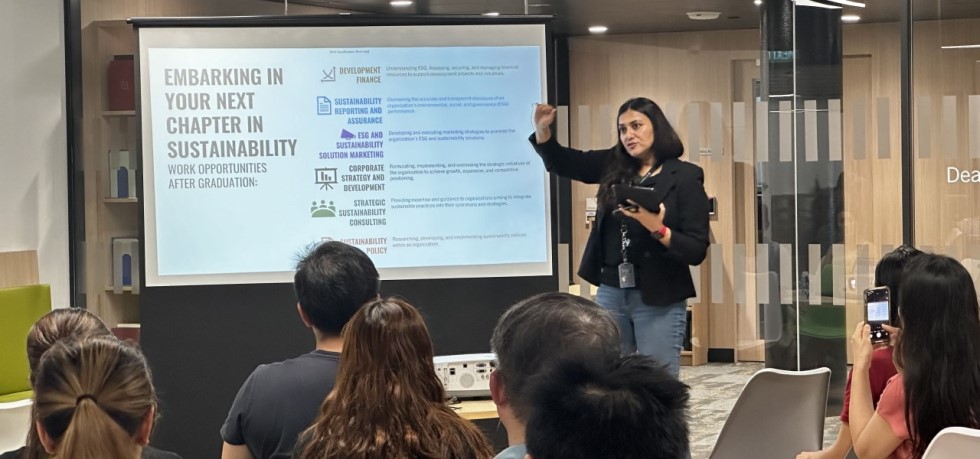Hydrogen, the most abundant element in the universe, has been hailed as the green fuel of the future. Its use is key in the decarbonisation of hard-to-abate industries such as shipping and steel production, where electrification is challenging. In Singapore, there is a national strategy to invest in and develop hydrogen further for decarbonisation.
Despite the enthusiasm surrounding the potential of hydrogen, many challenges will need to be overcome before this clean fuel can be widely adopted to make a meaningful dent in global emissions.
In a sample class conducted on 27 March 2024, Dr Ishani Mukherjee – Associate Professor of Public Policy and Master of Sustainability (MST) Programme Director at SMU – took prospective MST students through the complex landscape of the hydrogen economy, outlining its opportunities and challenges.
The one-hour class offered a glimpse into the MST programme’s approach to sustainability education: inter-disciplinary, constantly updated with current sustainability trends, and focused on equipping students for the ever-changing demands of the green economy.
Back to basics
For many decades, hydrogen has been used for various industrial processes. It plays a critical role in producing ammonia, which consumes more than half of the world’s hydrogen supply today. Hydrogen is also used in refining crude oil and methanol, an important resource for many chemical products.
On its own, however, hydrogen cannot be directly used as a fuel source. Its tendency to bond with other elements, forming compounds such as water, requires an energy-intensive process to break these bonds to harness hydrogen in its pure form. This process has long depended on fossil fuels, in which carbon dioxide is consequently released.
“This sets the stage for the argument in favour of ‘green’ or ‘low-carbon’ hydrogen,” explained Dr Mukherjee, highlighting the need for cleaner production methods. “This would bring about the hydrogen economy as a supply chain, which mirrors the networks currently used for distributing traditional energy products, such as electricity.”
The hydrogen prism
In her lecture, Dr Mukherjee also described the hydrogen colour spectrum, categorising the element into various types based on the method and environmental impact of their production.
Grey hydrogen is the most common form today, produced mainly through the process of steam reforming of natural gas, which is a fossil fuel. This method, while efficient in terms of production cost, leads to substantial carbon emissions – making it the least environmentally-friendly option.
Blue hydrogen is a step towards reducing the carbon footprint of hydrogen production. “It’s similar to grey hydrogen in terms of how it’s produced, but it incorporates carbon capture and storage technologies to mitigate the release of carbon dioxide into the atmosphere. Though cleaner, the sustainability of blue hydrogen production hinges on the effectiveness and scale of carbon capture technologies,” added Dr Mukherjee.
Another type of hydrogen is the less discussed pink hydrogen. It is produced through the electrolysis of water using nuclear power. While the process does not emit carbon dioxide, the public perception of nuclear power as a clean energy source remains contentious.
Green hydrogen is the cleanest form. Produced via the electrolysis of water using renewable energy sources such as wind, solar, hydropower, or geothermal, green hydrogen comes with zero emissions, aligning with a carbon-neutral energy landscape. However, it currently represents a small fraction of total energy production – approximately 0.1 per cent – due to high costs and technological challenges associated with scaling up renewable energy sources and electrolysis capacity.
Overcoming challenges with policymaking
The path towards a green hydrogen economy is punctuated by myriad challenges, according to Dr Mukherjee. These include inadequacies in hydrogen fuel storage and transport infrastructure, hydrogen fuelling stations, and knowledge and technical awareness regarding the complexities of producing and utilising green hydrogen. A robust and self-sustaining hydrogen ecosystem has yet to be fully realised.
But every challenge is an opportunity for innovation and human ingenuity. Addressing the associated challenges entails a concerted effort from governments and the private sector. Many countries recognise that achieving net-zero emissions will involve a mix of policies and targets, with hydrogen playing a vital role.

Dr Ishani Mukherjee, Associate Professor of Public Policy and Master of Sustainability (MST) Programme Director, sharing valuable insights with prospective MST students
At the same time, the current high cost of producing clean hydrogen – somewhat reminiscent of the steep prices of solar technologies two decades ago – necessitates government support.
“This cost barrier suggests that the market alone cannot drive the advancement of green hydrogen. Policy intervention and investment from governments are essential,” said Dr Mukherjee. “This includes upfront investment in technology and infrastructure, as well as the introduction of incentives to make green hydrogen more competitive.”
Dr Mukherjee also noted that while substantial investments have been made, the field is “short in the billions” when it comes to pushing hydrogen technology to a broader market. Here, the private sector’s involvement is crucial in closing this gap, with mature organisations that have a better grasp of sustainability practices leading the way due to their bigger risk appetite for novel technologies.
A level playing field
During the lecture, Dr Mukherjee also introduced the concept of ‘just transitions’, which underscores the importance of embedding fairness and inclusivity in policy decision-making. “Achieving net zero equitably should also be on the minds of policymakers,” she said.
Emphasising just transitions allows for the anticipation and mitigation of potential adverse impacts on communities, while maximising the benefits of energy transitions for all involved. Delineated at the 2021 United Nations Climate Change Conference (COP26), the framework for a just transition encompasses supporting workers in transitioning to new jobs, encouraging social dialogue, developing inclusive economic strategies, and ensuring equitable employment across supply chains.
In particular, the green hydrogen economy could serve as a catalyst for sustainable development in developing nations, where they stand to benefit from enabling technologies such as low-emission transport and remote power provision – a step towards achieving equitable and inclusive energy solutions for a sustainable tomorrow.
This class represents a taster for Dr Ishani Mukherjee’s module on Renewable Energy, a course unit in SMU’s Master of Sustainability programme. Find out more about the programme and upcoming sample classes or events here.





